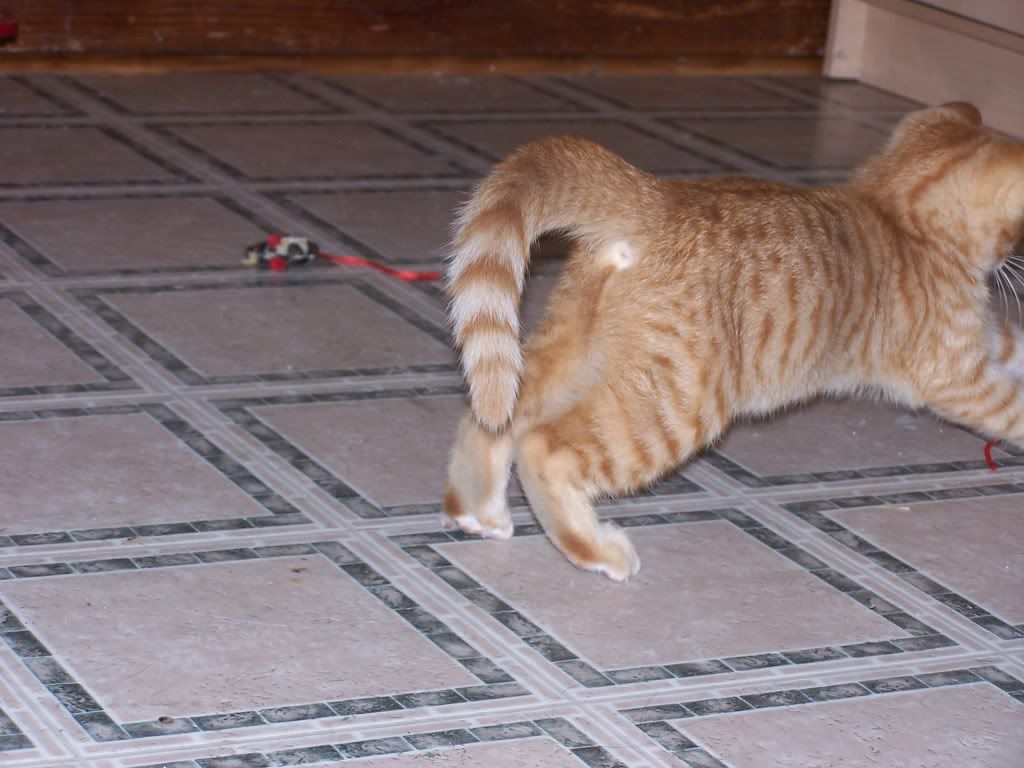I know I've said this about a billion times now, but take this process slow. Yes, I know you're excited, and yes, I know it can be inconvenient to have a cat locked away in your bedroom or bathroom or laundry room or wherever, but every negative interaction between your cats is just going to make the introduction process take longer and make it more frustrating for you.
Negative interactions between your two (or three, or four...) cats isn't the only thing that can slow down the process, negative interactions from you can slow it down too. Do not punish your cat for being upset, angry, or aggressive and do not force your cats to do anything they don't want to do, these things will do nothing but hurt your cause and slow you down on your path to a happy home.
 |
| Boo Radley, in the mud room turned kitten sanctuary, upon his arrival at our house. |
ONE SENSE AT A TIME
Undoubtedly, your cats know there's a newcomer in your home. There's probably been some high interest around the door that is hiding your new guy, and that's ok, because what we're going to do here is introduce your cats to each other one sense at a time.
One sense at a time is how zoos introduce big cats as well. Below is an excerpt from an article in the Chicago Tribune called "Young lion has big pawprints to fill at Lincoln Park Zoo".
"Sahar, who does not have a mane yet, is in quarantine and will be slowly and gradually introduced to Myra, a 15-year-old lion, Dewar said. The lions need to be able to smell each other, then see each other and eventually get close to each other, she said." (You can read the whole article here, if you're interested.)
The first sense we're going to focus on is hearing. This one is easy and requires almost no effort on your part but observation – your cats can hear each other through the door. All you have to do is listen to what they say to each other. If there is hissing, spitting, or similar, then keep that door closed and don't do anything more at this point. When the cats are consistently making friendly noises through the door (or just ignoring each other), proceed to the next sense.
Up next is smell. Their noses have already picked up that there's another cat in the house, and they've smelt each other's scent on you, now it's time to purposely spread their individual scents around the house. There are a few different ways to do this:
- Still while keeping them separate, rub each cat with a clean towel (or tee shirt, or blanket, or similar), then trade the towels out. Allow each cat to sniff and otherwise check out each other's towels. If they don't show any interest, put it in a spot were they can check it out on their own time.
- Give it a day or so, then do another trade out, this time with scratching posts. Allowing each cat to smell and use each other's posts will give them a plethora of information about their new roommate.
- Next, do a poop switch. Just scoop some out of new cat's litter box and put it in old cat's litter box, then vice versa.
- Finally, after you've gone through all these steps, do a full room switch out. Let your new cat wander around the house while your resident cat explores the room where new cat has been living.
Now it's time for sight. The goal here is to let the cats actually see each other for the first time without getting close enough to hurt each other. A screen or glass door works perfect for this, but if that doesn't work with the layout of your house, try and have a friend help you. Again, watch your cats reactions. If things are going positively, you may be able to let them interact, just be ready to swoop in if things start getting nasty. If there's hissing and ear flattening, or other signs of aggression, keep them separate and try another day.
When your cats are interacting for the first time, try to distract them with positivity. Get out some toys, pet and talk to them, bribe them with treats, whatever it takes for them to walk away from the experience thinking that it wasn't so bad.
Take it slow, and don't be afraid to take a step back if things don't seem to be going well. When it comes to the last two senses, touch and taste, allow your cats to decide on their own when they're ready to cuddle or help each other out with grooming.
Remember, to have a happy cat house you need to reduce competition. That means you have to have ample love and attention for each cat, separate food/water dishes, enough litter boxes (number of cats +1), and plenty of vertical space. If your cats feel like they have to compete for resources, it's going to take much longer for them to get along.